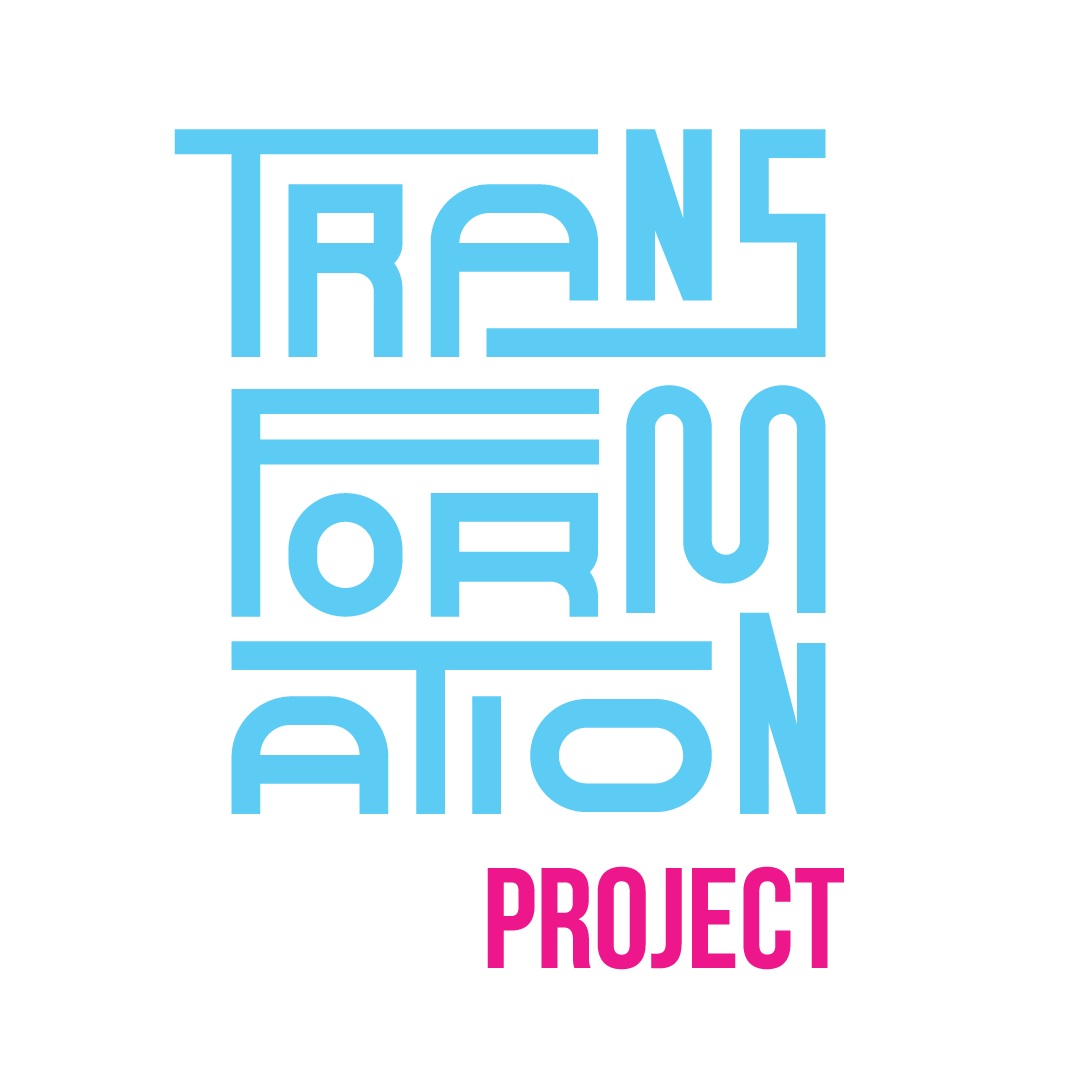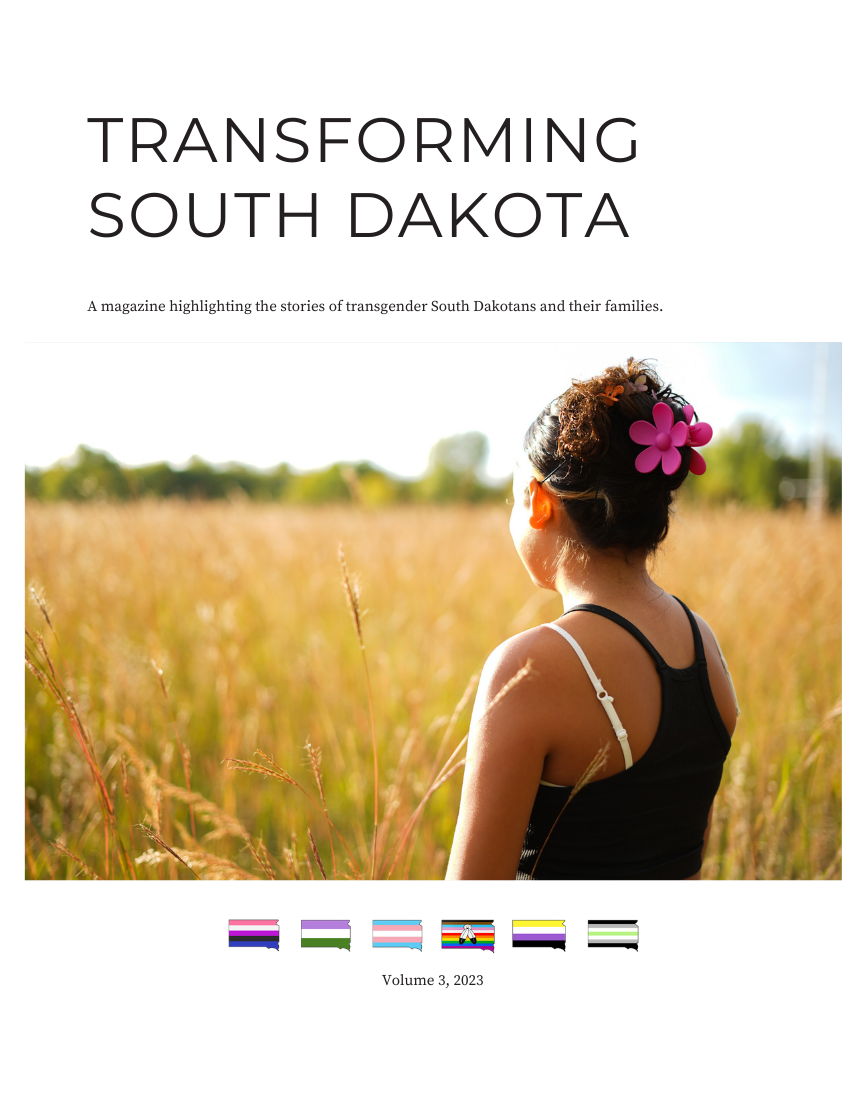
Transforming South Dakota Magazine
Highlights local transgender, nonbinary, gender-diverse and Two Spirit people and tells their stories.
Volume 3, 2023
Welcome to the 3rd edition of our publication, Transforming South Dakota. Over the last few years, we’ve introduced you to some of the amazing transgender and nonbinary people that call South Dakota and the surrounding areas home. In this issue, we want to introduce you to their families - the people who have taken the journey with their transgender and nonbinary loved ones. Some have struggled, some have always known, some have had a smooth transition, and some are still adjusting. Regardless, the common thread in these stories is the willingness to take the journey with the trans people in their lives. It is not always easy, but it’s worth it.
To request free copies for your non-profit organization, email magazine@transformationprojectsd.org.
Download a free PDF
We Know that
Words matter.
They can harm or they can heal. They can create division or draw people in.
The following pages provide a summary of key terms that are important to supporting the transgender community. This list is not exhaustive and definitions are always evolving.
-
An ally is someone who advocates for and supports a community other than their own. Allies are not part of the communities they help. A person should not self-identify as an ally but show that they are one through action.
-
Under the non-binary and transgender umbrella, agender refers to a person that has no gender identity or has a neutral gender identity.
-
Agender refers to those who identify as two genders or multi-gender (identifying as two or more genders). Bigender should not be confused with Two-Spirit, which is specifically associated with Native American and First Nations cultures.
-
Cisgender is the term for people whose gender is the same as the sex they were assigned at birth. Cisgender people sometimes don’t realize they are cisgender because they have not had to think about their own gender identity.
-
Exaggerated, theatrical, and/or performative gender presentation. Although most commonly used to refer to cross-dressing performers (drag queens and drag kings), anyone of any gender can do any form of drag. Doing drag does not necessarily have anything to do with one’s sex assigned at birth, gender identity, or sexual orientation. Drag began as a celebration of gender deviation, with origins in vaudeville and Shakespearean theatre.
-
Gender is a set of cultural constructs describing characteristics that may historically be related to femininity, masculinity, women, men, nonbinary people, and/or social norms.
-
A system of viewing gender as consisting solely of two categories, termed “male and female,” in which no other possibilities for gender or anatomy are believed to exist. The gender binary is oppressive to anyone who defies their sex assigned at birth, but particularly those who are gender-variant or do not fit neatly into one of the two standard categories. It largely ignores the existence of Intersex people and is used to exclude non-binary people.
-
Gender Dysphoria refers to the anxiety and/or stress that can be present due to a mismatch between sex assigned at birth and gender identity. Not all trans people experience gender dysphoria.
-
The physical manifestation of one’s gender identity through clothing, hairstyle, voice, body shape, etc (typically referred to as masculine or feminine). Many transgender people seek to make their gender expression (how they look) match their gender identity (who they are), rather than their sex assigned at birth. Someone with a gender nonconforming gender expression may or may not be transgender.
-
Gender identity that varies over time. A genderfluid person’s gender identity and expression may change constantly or be a fluid and slow movement. It is best to ask what pronouns each genderfluid person uses, whether their pronouns change, and how/if they want you to continue asking if they fluctuate.
-
One’s internal sense of being male, female, neither of these, both, or other gender(s). Everyone has a gender identity. For transgender people, their sex assigned at birth and their gender identity are not necessarily the same.
-
An identity commonly used by people who do not identify or express their gender in a binary. Those who identify as genderqueer may see themselves outside of or in- between the binary. Not everyone who identifies as genderqueer identifies as trans or non-binary. This can also be used as a blanket term for people who feel that they have a gender identity that falls outside of the societal norm.
-
This term refers to the assumption that heterosexuality is the norm, which plays out in interpersonal interactions and society and furthers the marginalization of queer people.
-
A person with a less common combination of hormones, chromosomes, and/or anatomy that are used to assign sex at birth. Intersex people are often assigned to a gender within the binary at birth without their permission. It should be noted that intersex people are born approximately as often as people with red hair are.
-
Used as an adjective, this is an umbrella term for genders other than exclusively binary female/male or woman/man genders. Non-binary identity falls under the larger umbrella of transgender identity, but non-binary individuals may or may not identify as transgender.
-
Typically refers to a transgender person being perceived by others as cisgender instead of one’s sex assigned at birth. The term is both widely used and debated within the transgender community as the term relies on arbitrary societal gender norms and can connotate deception, so be careful with its use. For trans people, passing may or may not be desired and is generally not within a person’s control.
-
A trans person who is perceived as cisgender may experience less prejudice, harassment, and risk of violence as well as better employment opportunities. Also known as “cis-assumed privilege,” which means people assume the transgender person is cisgender, this shows the reliance on assumptions for this privilege and removes the debated term “passing”.
-
General term for gender and sexual minorities who are not cisgender and/or heterosexual. There is a lot of overlap between queer and trans identities, but not all queer people are trans and not all trans people are queer. The word queer is still sometimes used as a hateful slur, so although it has mostly been reclaimed, be careful with its use.
-
A person’s identity in relation to the gender(s) they are romantically attracted to, such as who a person might want to date or have a romantic relationship with. Romantic orientation is often in alignment with one’s sexual orientation, but not necessarily.
-
A set of characteristics associated with reproduction and biology that generally assign individuals into categories of “male” and “female.”
-
The assignment and classification of people as male, female, intersex, or another sex assigned at birth often based on physical anatomy at birth and/or karyotyping (an individual's collection of chromosomes).
-
A person’s inherent identity in relation to the gender(s) they are sexually attracted to, which may or may not correspond with one’s romantic orientation. In Western cultures, gender identity and sexual orientation are not the same. Trans people can be straight, bisexual, lesbian, gay, asexual, pansexual, queer, etc. For example, a trans woman who is exclusively attracted to other women would often identify as lesbian. description
-
A transgender person who navigates the world with cis-assumed privilege (see passing privilege) and is not openly transgender to others. Opposite of visible. Some trans individuals may be stealth in all aspects of life, while others may choose to be stealth in only some situations, for example, at work. Similar to the term passing, this term is debated within the transgender community because of the connotations of deception and should be used with caution.
-
An umbrella term for people whose gender identity differs from the sex they were assigned at birth. The term transgender is not indicative of gender expression, sexual orientation, hormonal makeup, physical anatomy, or how one is perceived in daily life. *Note that transgender does not have an “ed” at the end.
-
A person’s process of developing and assuming a gender expression to match their gender identity. Transition can include: coming out to one’s family, friends, and/ or co-workers; changing one’s name and/or sex on legal documents; hormone therapy; and possibly (though not always) some form of surgery. It’s best not to assume how one transitions as it is different for everyone.
-
Systemic violence against trans people associated with attitudes such as fear, discomfort, distrust, or disdain. This word is used similarly to homophobia, xenophobia, misogyny, etc.
-
Trans man generally describes someone assigned female at birth who identifies as a man.
-
Trans woman generally describes someone assigned male at birth who identifies as a woman.
-
An umbrella term indexing various Indigenous gender identities, and in some cases sexual orientations. Two-Spirit people carry both masculine and feminine entities and can cross social gender roles, gender expressions, and sexual orientations. Every tribal nation and culture have their own language and traditional roles for Two-Spirit people, and only Indigenous people may use this term to describe themselves.
-
A transgender person who is openly transgender regardless of how others perceive them.

